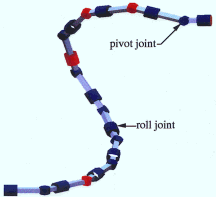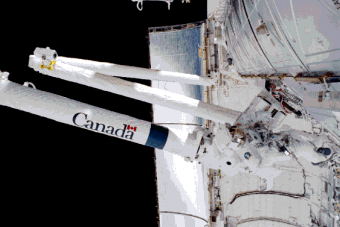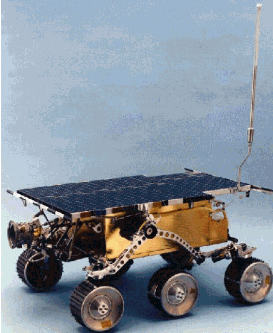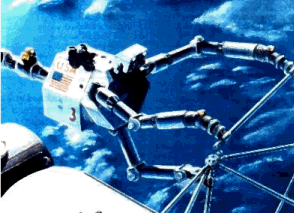|
|
Robots In Space
|
 |
Applications outside the Earth's
atmosphere are clearly a good fit for robots. It is
dangerous for humans to get to space, to be in space and
to return from space. Keeping robots operating reliably
in space presents some unique challenges for engineers.
The ultra-high vacuum in space prevents the use of most
types of lubricants. The temperatures can swing wildly
depending on whether the robot is in the sun light or
shade. And, or course, there is almost no gravity. This
is actually more of an opportunity than a challenge and
leads to the possibility of some unique designs. The
conceptual robot at left has 21 independent joints. On
earth it would be impossible for this robot to support
its own weight, but in space, the design presents some
unique capabilities. The robot can reach around
obstacles and through port holes. The robot also
possesses a huge degree of fault tolerance. It can
continue to operate with excellent dexterity even after
several joints fail. |
|
|
|
The robot at right is called Robonaut.
It is a humanoid robot designed by the Robot Systems Technology Branch at NASA's
JSC in a collaborative effort with DARPA.
Robonaut's creators designed it to have dexterity, range
of motion and task capabilities roughly equivalent to
that of an astronaut in a space suit. Space flight
hardware has been designed for servicing by astronauts
for the last fifty years. It makes sense that robots
would gradually pick up these tasks over time rather
than suddenly replacing astronauts. The set of tools used by astronauts
during space walks was the initial design consideration for the
system. This drove the development of Robonaut's dexterous five-fingered hand and human-scale arm.
The robot's mix of sensors includes thermal, position, tactile, force and torque
, with over 150 sensors per arm. The control system for Robonaut includes an
onboard CPU with miniature data acquisition and power management in an
environmentally hardened body. He's also got a nifty
thermal suit to protect him from the wild temperature
swings in space. |

|
|
|
 |
At left we see the Canadarm robot
arm, a version of which has flown on every Space Shuttle
flight for the last twenty years. The arm has a shoulder
with 2 DOF, an elbow with 1 DOF and a 3 DOF wrist. The
arm is routinely used as a mobile work platform for the
astronauts, for "tossing" satellites into
space and for retrieving faulty ones. Non-routine uses
have included: knocking a block of ice from a clogged waste-water vent, pushing a faulty antenna into place, and activating a satellite that failed to go into proper orbit.
Several of these arms have been in service for twenty
years. A true robot success. |
|
|
|
At right we see a press photograph of
the Sojourner mobile robot that ultimately explored the
surface of Mars. This is more of an R/C car than a robot
as it was completely remote controlled from Earth, but
NASA calls it a robot so I will too. In any case, the
pictures it provided from the Martian surface were
breath taking. Sometimes I think that really cool
pictures may be NASA's greatest contributions. The deep
field images produced by the Hubble telescope are in my
opinion some of the greatest wonders of mankind.
The Sojourner is a 6-wheeled vehicle of a rocker bogie design which allows the traverse of obstacles a wheel diameter (13cm) in size. Each wheel is independently actuated and geared (2000:1). The front and rear wheels are independently steerable, providing the capability for the vehicle to turn in place. The vehicle has a top speed of 0.4m/min.
It is powered by a 0.22sqm solar panel comprised of 13 strings of 18, 5.5mil GaAs cells each. The normal driving power requirement for the microrover is 10W. |

|
|
|
|
 |
NASA decided to develop a $288-million
Flight Telerobotics Servicer (FTS) in 1987 to help astronauts assemble the Space Station, which was growing bigger and more complex with each redesign. Shown here is the winning
robot design by Martin Marietta, who received a $297-million contract in May 1989 to develop a vehicle by 1993.
About the best thing that can be said for the FTS
project was that it generated a lot of lessons learned.
The robot never flew and never will fly because it was
never completed. This project demonstrated that
fault-tolerance gone wild will doom a robot. The robot
had so many redundant systems that there was just too
much to go wrong. |
|
|
|
|